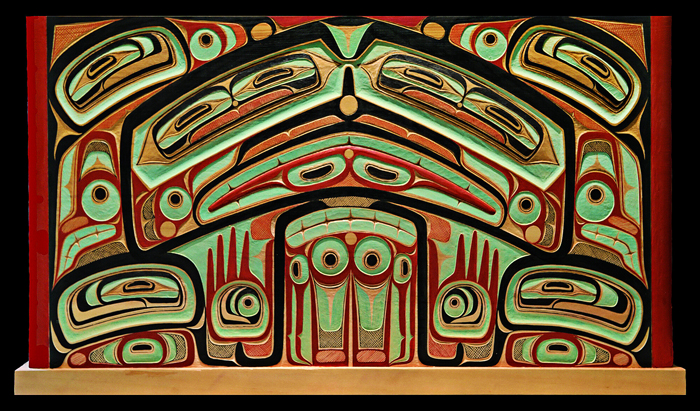Press Release
To investigate new dialogic possibilities based on the encounter between the production of artists of the indigenous peoples Guna (Comarca Kuna Yala, Panama), Haida (Haida Gwaii archipelago, British Columbia, Canada), Huni Kuin (Indigenous Land of the Upper Rio Jordão, Acre, Western Amazon, Brazil), Shipibo-

Amerindian Ecounters
Sesc Vila Mariana, Sao Paulo (Brazil)
31.07.2021 - 13.02.2022

“The idea of an encounter of alterities is fundamental to the Amerindian socio-
With works by Tahltan multimedia artist Alano Edzerza; the sculptural work of the Haida brothers Gwaai and Jaalen Edenshaw; the overlayings of fabrics by Guna artists Ana Bella Fernandez, Angelmira Owens Perez, Benilda Mores, Briseida Iglesias, Buna Bipi, Conciencia Grace Rodriguez, Dilma Gardel, Edita Lopez, Emilsy Fernandez, Flor Fernandez, Gilda Tejada, Lea Amelta Tejada, Lonilda Gonzalez, Lucrecia Places, Rosalia Tejada and Victoria Gonzalez; the geometric patterns embroidered by Shipibo-
Due to the dynamics of the colonial system, it has only been in recent decades that the artistic production of Amerindian peoples has garnered recognition and valorization in the art field—to a great extent in North America and Oceania and, only later and more slowly, in Latin America. Previously relegated to the status of an ethnographic object or merely handicraft, these works—which are arriving at an ever-
Even though they share similar historical experiences of colonial oppression and domination, as well as of community and ethnic resistance—the artists featured in the show possess diverse artistic aesthetic preferences and, inspired by ancestral knowledge, they are creators of singular visualities linked to mythological, ecological and cosmological relationships.
Encontros Ameríndios reflects, therefore, one of the premises of Sesc São Paulo, which is the valorization of cultural diversity. In this exhibition, beyond the anthropological perspective, a further aim is to foster an approximation of the cultural manifestations of these peoples based on artistic criteria—of works ranging from their paintings with natural pigments to their digital-
About SESC São Paulo
SESC – Social Service of Commerce is a private, nonprofit institution created in 1946 by businesspeople in the commerce and services sector from all over Brazil. In the State of São Paulo, SESC has 42 centers providing public access to culture, education, sports, leisure, and health. SESC São Paulo’s actions are oriented by its educational aim and its striving for social welfare based on a broader understanding of the term culture.

Gwaai and Jaalen Edenshaw, Child of the Great Box, 2014. Photo: Mike Peckett.
Exhibition July 31, 2021–February 13, 2022. Sesc Vila Mariana, Rua Pelotas, 141 -

© ArtCatalyse International / Marika Prévosto 2021. All Rights Reserved